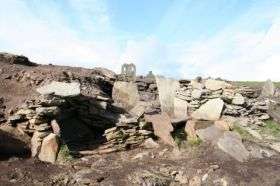Bronze Age building saved from the sea

A team of archaeologists have saved a Bronze Age building on Shetland from destruction by the sea... by moving it brick by brick to a safe new location.
The piece of history on the island of Bressay, dating from between 1500 - 1200 BC, was first discovered during an excavation eight years ago. Concerned that the site was still under threat from coastal erosion, University of St Andrews researcher Tom Dawson and Helen Bradley of Archaeology Scotland, launched a campaign to save it earlier this summer.
After the painstaking removal of the entire site, the building will be officially opened to the public at its new site this weekend (Saturday 23 August) by local MSP Tavish Scott.
The ancient building at Cruester is thought to be linked to a nearby `burnt mound', a large heap of fire-damaged stones thought to be once used for feasts, baths or saunas. Burnt mounds are quite common throughout Britain and Ireland, but very few of them have been found with associated structures, giving the Bressay building special archaeological significance.
For the last three months, archaeologists, specialists and a hardy group of local volunteers dismantled, photographed and numbered each stone - some of them massive - before moving them carefully to their new location.
St Andrews archaeologist Tom Dawson said, "Coastal erosion is threatening thousands of sites around Scotland, and the local group here came up with a novel idea for dealing with the problem. Although this approach isn't practical everywhere, it is great to have had the chance to give new life to this particular site and make it accessible to future generations, while also learning something new, not just about Cruester, but about burnt mounds in general."
The summer reconstruction follows the 2000 excavation by EASE Archaeology, which located a series of dry-stone walled cells, connected by two corridors. At the end of one corridor was a hearth cell, thought to have been used for heating stones. At the other end was a tank sunk into the ground and constructed of large slabs of stone (stones were heated and then plunged into a tank of water). The tank was almost two metres long, over a metre wide and half a metre deep and it is thought that large pieces of meat were boiled there. The passageway was inclined downwards from the hearth to the tank, which may have helped in moving the hot stones to the water.
Though the site was covered up immediately after the original excavation, the local Bressay History Group were concerned that erosion was still affecting the site and asked for help from the University of St Andrews-based SCAPE (Scottish Coastal Archaeology and the Problem of Erosion) and the Adopt-a-Monument Scheme of Archaeology Scotland.
After successfully securing funding from the Heritage Lottery Fund, Shetland Islands Council, HIE (Highlands and Islands Enterprise) and Shetland Amenity Trust, a plot of land was obtained next to the Bressay Heritage Centre, which lies just by the island's pier, a ten-minute ferry ride from Shetlands capital, Lerwick.
EASE Archaeology were contracted to supervise the excavation, and a specialist team of dry-stone builders, who have recently been working at the Old Scatness Broch project, worked on the reconstruction.
Tom Dawson and Helen Bradley supervised the project and were delighted with the way that it progressed, finally resulting in the structures being rebuilt stone by stone, with everything being placed at the new location exactly as it was at the original site.
Helen, of the Adopt-a-Monument Scheme, commented, `Even moving the stones with modern machines was a job; it really makes you appreciate what the Bronze Age builders must have gone through. Now that the site has been adopted, I am really looking forward to seeing how the local group works with the site over the years."
Tom said, 'This has been a fantastic project, and it would not have been possible without the great support that we have had from so many members of the local community. Seeing the stones from the original building being transported away in a fleet of tractors was a fantastic sight'.
In addition to moving the Bronze Age building, a second structure was built for holding a series of 'live history' events - Bronze Age experiments aimed at determining how, and why, burnt mounds developed. It is hoped that over the next few years, Open Days will be held at the site and the tank will be used for cooking and industrial purposes.
Tavish Scott MSP commented before the opening, "This project is a splendid partnership between the Bressay History Group and outside bodies who care for Shetland's archeological heritage. This exhibition will be a great asset for visitors to Bressay and local people. The more we understand about the past, the better informed we are about the future."
The launch of the new site will include guided tours and demonstrations of Bronze Age activities, including an experimental firing of the reconstruction. For further information and images visit www.shorewatch.co.uk/cruester
Provided by University of St Andrews





















